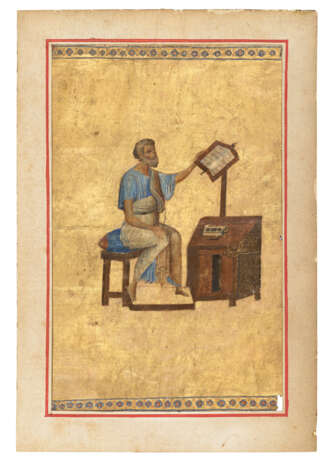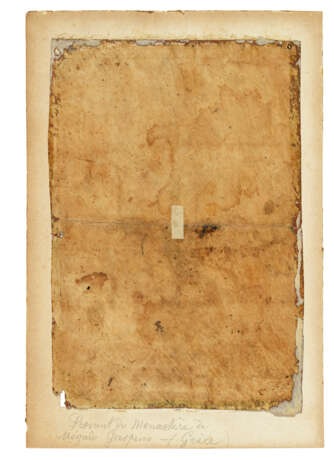ID 870878
Los 2 | Anonymous Byzantine painter
Schätzwert
£ 20 000 – 30 000
St Matthew writing his Gospel, miniature on vellum from a Gospel book or Gospel Lectionary in Greek [eastern Mediterranean, 11th century]
An 11th-century Byzantine miniature from a Gospel book.
240 x 165mm. Full-page miniature depicting St Matthew sitting before his writing desk, on which lie a pen and inkwell, reaching up to touch his Gospel, the miniature presumably opening the Gospel of Matthew. Two columns of text faintly visible above the Evangelist, the right-hand column with the ‘θ;ία’ of ‘?ατταθ;ίας’ [Matthew] just legible, narrow frame of geometric design at upper and lower borders, the Evangelist shown before a writing desk; recto blank (later repainting of the Evangelist, the leaf cropped with holes or losses at the corners and either side of the horizontal central crease, rubbed). Card mount (285 x 193mm).
Provenance:
(1) The style of the miniature suggests that it was painted in the Byzantine Empire in the 11th century. Manuscripts of the period typically had miniatures tipped in once the text was complete; the blank side of our leaf was presumably the recto, with the miniature facing the opening of the Gospel of Matthew in either a Gospel book, a manuscript containing the Gospels of the four Evangelists, or a Gospel Lectionary, a manuscript containing excerpted Gospel readings arranged according to the liturgical year of the Orthodox Church.
(2) ‘Provient du monastère de Megalo Gaspino – (Grèce)’; according to a 20th-century pencil inscription on the mount. Perhaps a mistransliteration of ‘Mega Spilaio’: the monastery of Mega Spilaio, reputedly founded in 362, is situated near to Kalavryta on the Peloponnese peninsula of southern Greece; its library was among the buildings destroyed by fire in 1934 and Pinakes lists 364 manuscripts as ‘destroyed’.
(3) Charles Ratton (1895-1986), of Galerie Ratton-Ladrière, Paris, owned in the 1920s; according to a note added to a black-and-white photograph of our miniature in the Kurt Weitzmann Archive in the Department of Art and Archaeology at Princeton.
(4) Apparently acquired from Gruel in November 1940, and by descent to the present owners.
Illumination:
Strong emphasis was placed on tradition in Byzantine art, resulting in a great similarity between Evangelist portraits across Gospel manuscripts painted in the eastern Mediterranean between the late 9th and the 12th century, a period of renaissance for manuscript illumination following the end of Iconoclasm in 842. Broader stylistic trends can be identified: the 11th century saw the Evangelists clad in smooth, flowing drapery, which by 1200 had given way to more convoluted folds; our St Matthew belongs to the earlier of these periods. The treatment of the figure of the Evangelist, the spacious composition and the slim geometric frames of simple design surrounding the miniatures are comparable to two 11th-century depictions of St Matthew in Gospel books at the Russian State Public Library (St Petersburg, Gr. 801, f.2v and Gr. 72, f.13v).
Locating a place of production is more challenging. Constantinople, capital of the Greek-speaking Empire and site of the imperial scriptoria and the great monasteries, was a major centre of manuscript production in this period, and the colophons of many manuscripts testify to their production there. However, the provincial centres were of equal importance, with manuscripts produced in monasteries and towns across the Empire: in Thessaloniki, Cyprus, Palestine, Asia Minor, and Mount Athos.
Christie’s is grateful to Georgi Parpulov for confirming the dating of the present miniature.
Special notice
This lot has been imported from outside of the UK for sale and placed under the Temporary Admission regime. Import VAT is payable at 5% on the hammer price. VAT at 20% will be added to the buyer’s premium but will not be shown separately on our invoice.
| Herkunftsort: | Griechenland, Europa |
|---|---|
| Kategorie des Auktionshauses: | Handschriften des Mittelalters und der Renaissance |
| Herkunftsort: | Griechenland, Europa |
|---|---|
| Kategorie des Auktionshauses: | Handschriften des Mittelalters und der Renaissance |
| Adresse der Versteigerung |
CHRISTIE'S 8 King Street, St. James's SW1Y 6QT London Vereinigtes Königreich | |
|---|---|---|
| Vorschau |
| |
| Telefon | +44 (0)20 7839 9060 | |
| Aufgeld | see on Website | |
| Nutzungsbedingungen | Nutzungsbedingungen |




